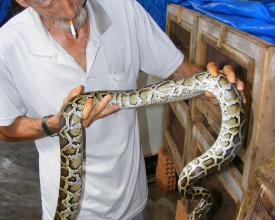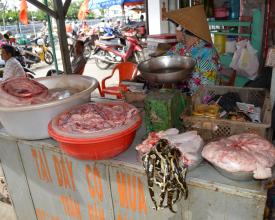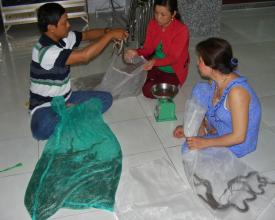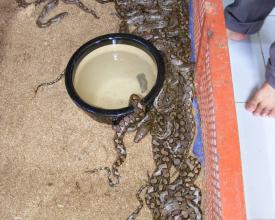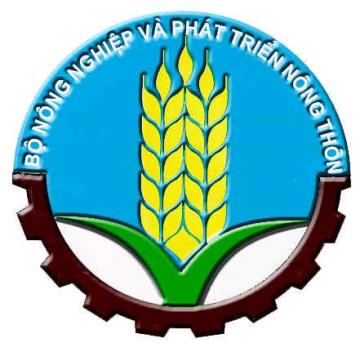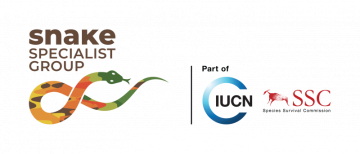
Reptile farming as a response to livelihood insecurity in the Mekong Delta
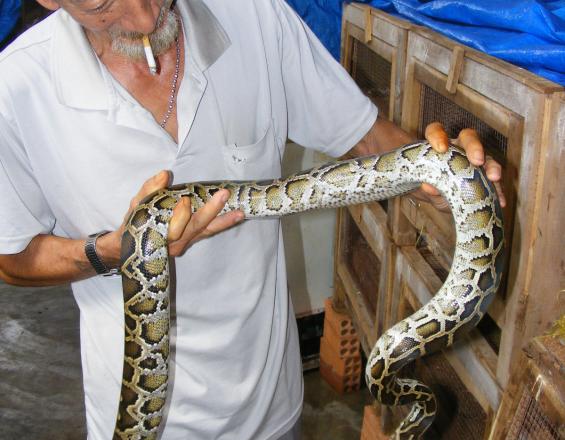
Extreme weather events and disease outbreaks represent growing threats to chicken and pig farmers in the Mekong delta. As an alternative, reptiles are a popular choice for many of the 21 million residents. Because of the physioloigcal efficiency attributes of reptiles (e.g., ectothermic or “cold-blooded”), many reptile production models have the potential to be economically viable and ecologically sustainable. A study published in 2009 in the International Journal of Food Microbiology found that the most significant microbiological risk associated with eating reptiles is Salmonella, and a growing body of evidence suggests birds and mammals represent the greatest zoonotic disease threat. In effect, reptile farming helps to build resilience in local agri-food systems and minimise the prevalence of zoonotic diseases.
Contexte
Challenges addressed
Vietnam has a rich culinary history in agrobiodiversity, including the consumption of reptiles. Challenges such as droughts, heatwaves, pandemics, greenhouse gas emission, and resource deficiencies are undermining mainstream livestock industries. Commercial bottlenecks and investment bias towards conventional corporate livestock systems have handicapped the development of localised, more sustainable and resilient alternatives such as reptile farming.
Emplacement
Traiter
Summary of the process
Legal and policy frameworks are essential prerequisites for reptile farming. These are not always easy to develop given the temporal and spacial proximity to stringent conservation regulations and wildlife trade laundering. Education and awareness at all stakeholder levels are important to justify legal and policy frameworks and consider the interactions with broader sustainablity criteria (e.g., conservation, environment pollution risks, and social upliftment). Farming reptiles requires specialist skills and considerations. Resolving the lack of skills and precedent amongst the farming community requires training and capacity development. Once equipped with technical knowhow, low start-up and running costs coupled with diverse business opportunities provide small-scale farmers with an attractive proposition. Mitigating risks associated with human and animal health will require ongoing multidisiplinary and cross-cutting research in areas such as water pollution and infectous diseases linked to reptile production systems.
Building Blocks
Legal and policy frameworks
Legitimate closed-cycle reptile farming is a relatively new phenomenon. Many Vietnamese reptile farmers were subsistence farmers who shifted over to reptile farming by modifying traditional poultry- and pig-type systems. The trade in wild caught reptiles was rife up until the early 2000s, and laundering through so-called ‘reptile farms’ was commonplace. However, as technological knowhow advanced, legal and policy frameworks were established by the Vietnamese government to permit the establishment of legitimate reptile farms. Many of these farms remain small-scale and operate within the informal sector, but governance mechanisms and appropriate institutional capacity have been able to establish successful structural and functional outcomes in terms of legality, animal welfare, transparency, and environmental sustainability. Reptile farming in Vietnam is regulated by the Ministry of Agriculture and Rural Development. Farms must be registered to and supervised by Provincial Forest Protection Departments (PFPD). PFPDs inspect facilities on a regular basis. Permits and certificates are issued to verify responsible sourcing practices (e.g., captive bred) in compliance with the law.
Enabling factors
Consolidation and unification amongst stakeholders has strengthened institutional capacity. This has been complemented by support from key government departments and international organisations. Stakeholders include existing reptile farmers, national bodies responsible for wildlife conservation, agriculture/aquaculture, food standards and trade, and international organisations such as IUCN, CITES, and ITC.
Lesson learned
Cooperation between small-scale farmers can be challenging. Willingness to participate and collaborate can be sporadic. Public perceptions of informal sector products linked to the wildlife trade can be negative. Multi-stakeholder engagement – top-down and bottom-up – is important.
Education and awareness
Until recently there was minimal agricultural precedent or appreciation for farmed reptiles, and most people strongly preferred wild-caught alternatives. Vietnam has since celebrated the success of the reptile farming industry, and the general public are now well informed about the industry and the end products. Farmed reptile products are available in most wet markets and on the menu of many mainstream restaurants. A remaining challenge is that there has been no attempt to regulate or inform customers of what farmers feed to their reptiles. Wild-sourced animals (e.g., rodents captured in rice fields), commerical feeds (e.g., fish pellets), and waste protein from agri-food chains (e.g., still born pigs and male chicks from hatcheries) are the most common feed types. The risks associated with these feed inputs need further research and evaluation. The risk of wild laundering of reptiles also remians, but the scale and likelihood have been significantly reduced through more lucrative production models (e.g., selective line breeding to improve production genetics) and improved law enforcement.
Enabling factors
Institutional support, workshops, social media, and government media outlets (e.g., national television). Cheap smartphones and access to the internet.
Lesson learned
Communication has been limited to direct social, economic, and nutritional benefits. The public remains largely unaware of the less tangible benefits of reptile farming such as those related to emerging global challenges (e.g., zoonotic disease, climate change, and environmental sustainability). Science-based content via social media platforms can be a powerful education tool for complex, cross-cutting themes. Ongoing research and development of health and veterinary aspects of reptile farming are required to aligne with international livestock standards.
Training and capacity development
Because of their ectothermic physiology, reptiles require specialised environments to thrive. For example, thermal and humidity parameters are critical for growth and reproduction. Production requirements are very different to those required by traditional warm-blooded livestock. These fundamental understandings are not always intuitive, and therefore require specialised education and training. Private and public sector actors have hosted workshops and produced resource materials (e.g., ‘how to’ principles and guidelines, posters) to assist farmers.
Enabling factors
Institutional capacity, public sector support (ITC, CITES, VN government), private sector financing (e.g., reptile leather industry). In September 2022, Vietnam held a workshop to introduce the Responsible Reptile Sourcing Standard. This standard is specifically designed to align the reptile industry with modern international standards in animal welfare, humane slaughter, and production.
Lesson learned
Introducing novel food and livelihood systems to risk-adverse communities operating in the informal sector, and particularly those with deep rooted traditions in warm-blooded livestock, can be challenging. Most reptile farmers are unaware of the synergies that exist between reptile husbandry and modern agricultural technologies. For example, dovetailing the biology of reptiles (e.g., basking behaviour) with modern greenhouse technology can have a multiplier effect on produciton outputs. The Vietnamese reptile industry is still some way behind modern, mainstream livestock sytems in many regards. Going forward, ongoing research and development (particulary in the fields of reptile livestock veterinary science and environmental sustainability) will be essential.
Low start-up and running costs
A number of different reptile species are farmed in Vietnam, ranging from small turtles and lizards to large pythons and crocodiles. Production scales are equally diverse, ranging from micro to industrial factory farms. Market entry requirements for some species are minimal, and many production models can be synergised with existing livelihood strategies at minimal cost. For example, snake farming can compliment seasonal rice growing via free ecological pest management (i.e., harvesting rodent pests to feed farmed snakes).
Enabling factors
Enclosure materials are typically cheap and readily available (e.g., similar to backyard poultry). Vertically orientated housing designs, low waste output, and minimal freshwater requirements allow for commercially viable production models at the micro-scale in high density urban settings.
Lesson learned
Volatile trends in the food and fashion industry and public perceptions of reptile products can impact the viability of small-scale, independent entities. The recent COVID-19 pandemic has resulted in the closure of some small-scale farms that rely on meat exports. Stabilising supply and demand dynamics is essential for the long term viability and growth of the industry.
Economic drivers
Reptile farming is well positioned to capitalize on emerging markets. Until recently, reptiles have been somewhat overlooked and undervalued due to colonial legacies and euro-centric agri-food tendencies towards warm-blooded livestock. Reptile products are mostly valued in the Global South where the impacts of climate change are predicted to be acute and the drivers for transformational change are dynamic. Dovetailing a novel agri-food sustainability concept with traditional cultural and culinary values in tropical regions offers unique economic opportunities. That said, future growth will depend on good farming practices and close supervision by veterinary and other authorities. Research on envionmental impacts and broader health implications (e.g., feeding unprocessed animal waste protein to reptile livestock) is essential.
Enabling factors
The reptile industry holds substantial growth potential. Established local and international markets exist for meat, skins, pets, and various body parts used in the pharmaceutical industry (e.g. squalene oil). Farmers are typically linked to multiple revenue streams and financial risks are spread across multiple geographies. These economic opportunities are complimented by the ability to scale management inputs and outputs in accordance with adaptive physiologies in order to buffer farmers against the impacts of economic and environmental shocks.
Lesson learned
Many reptile production models are expanding via vertical and horizontal integration (i.e., emergence of corporate factory farms). Development approaches that focus purely on economic profitability may compromise the viability of small-scale production models and threaten key animal welfare, environmental, and social sustainability credentials. The loss of democratic food systems presents a risk to regional food security and food sovereignty.
Impacts
As ectotherms, reptiles are physiologically different to humans. Zoonotic disease transmission requires mutually compatible physiological environments. Reptiles are carriers of zoonotic bacteria such as Salmonella, but they have never been linked to any major viral pandemics.
Reptiles require ~90% less food inputs compared to warm-blooded livestock. The metabolic efficiency of reptiles means that production systems typically require less food and freshwater compared to warmblooded livestock. They also produce comparatively little waste or greenhouse gasses.
That said, emperical evidence on the broader risks to human health (e.g., wild harvested rodents fed to captive reptiles) and environmental sustainaibliy (e.g., water pollution) is lacking and requires further investigation.
The ability to regulate metabolic rate allows some reptile species to drink and feed intermittently. Flexible metabolic rates help to dampen the impacts of volatile supply chains. For example, pythons can survive for several months without food or water, and are thus able to withstand the impacts of extreme weather events.
Reptile meat is high in protein and low in saturated fats. Reptile farms provide a source of nutrient-dense food in parts of the world where malnutrition and childhood stunting are increasing due to poverty.
Beneficiaries
Primary beneficiaries include farmers in the Mekong Delta and the communities they support. Secondary beneficiaries include billions people in tropical countries who traditionally eat reptile meat.
Sustainable Development Goals
Story
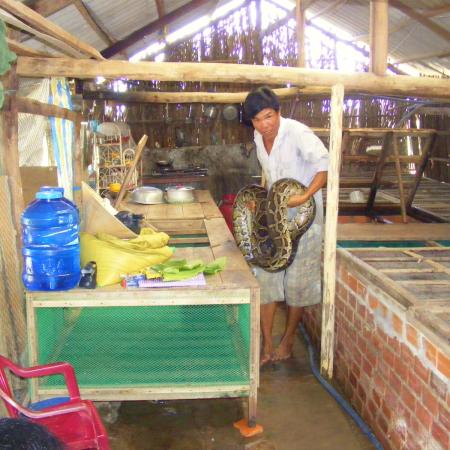
Nguyen Van Tri is a farmer near Cau Mau in the Mekong Delta. He owns 10 acres on which he grows rice, vegetables, and bananas. He has two fish ponds and raises a small number of ducks and chickens around his homestead. The produce from his farm feeds his family of six and generates a small profit. In recent years, drought, storm surge, and salinization from a neighbouring shrimp farm have reduced his rice harvest. Disease has also taken a toll on his poultry. Five years ago he started snake farming after reading an article in the local newspaper. He bought his initial stock from a breeding farm near Ho Chi Minh City and built cages using cheap, local materials. It was easy to set up, and because he feeds his snakes on rodent pests he traps around his rice fields, his running costs are minimal. The work is easy and requires comparatively few inputs. Mr. Nguyen doesn’t have to rely so heavily on his rice harvest anymore, and because his snakes can survive months without food, he doesn’t have to worry about fluctuations in the local rodent population; he simply feeds as much as he can whenever he can. Recently he bought a new moped with the money he made from the sale of snake skins. To celebrate, Mrs Nguyen cooked a snake hot pot using a traditional recipe passed down by her grandmother.
